
Official Edgar Rice Burroughs Tribute and Weekly Webzine Site
Since 1996 ~ Over 10,000 Web Pages in Archive
Volume 3954
Presents
Edgar Rice Burroughs
And
The Accreted Personality
Part V by R.E. Prindle
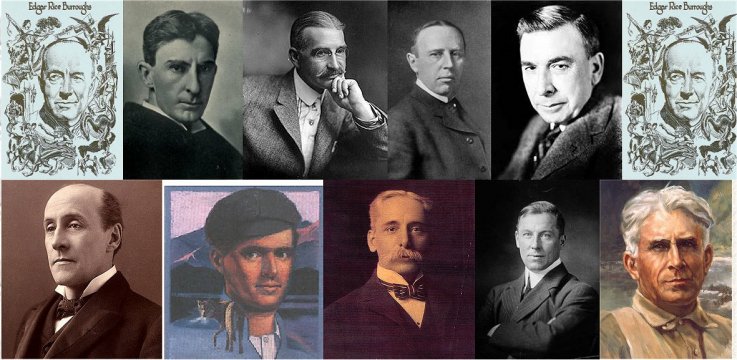
Hours In The Library


As the fabulous Twentieth Century dawned virtually a new world different than anything that had gone before came into existence requiring a new consciousness. As usual some could adapt and some couldnít. In an evolutionary sense those that couldnít adapt disappeared, those that could survived while those born into the new world accepted it as normal.
Many authors who were very successful in the old world faded from importance not because what they had to say was necessarily irrelevant but because it was no longer relevant to a changed consciousness. Even if their message was universal it had to be expressed in new terms. Some like Rider Haggard and Conan Doyle trundled right along until they died two or three decades later. Some like H.G. Wells whose contemporary novels lost significance and sales potential even though in Wells case his sci-fi output of the nineties has survived strongly until today. His omnibus volume Seven Science Fiction Novels has been a strong seller for nearly a hundred years. A dozen or so handsome editions adorn the shelves of second hand dealers where they turn over at a quick rate.
Still, around 1900 a new generation of writers began to move onto the literary field; the next wave after the crop of the eighteen eighties. The new writers were mainly in the age cohort of 1865 to 1876 as was Ed, but he would make a late start in 1912. Memory is the key to psychology. If nothing goes into the memory nothing comes out so it is important to include only the beneficial as much as is possible. It is for that reason that pornography is pernicious. It has little social value; its main function being to stroke oneís fixations. In these crucial years Ed filled his memory banks with the works of the current crop of writers. He unerring went, as we all do, to those writers and books that talked around his own fixations thus being capable of being incorporated into his own writing.
While he seems to be almost plagiarizing his sources, by the end of the nineteenth century the body of work available had grown to significant proportions. He was not alone in incorporating his reading into his own work. The reading had become part of the social fabric not much different than trolley cars and the soup cans Andy Warhol would later make famous. Burroughs now is part of our mental furniture and while it may not be pertinent to our writing, images and phrases from what we have read may come out of our pen without our realizing it. Almost like saying for dinner I opened a can of Campbellís tomato soup.
The thousands of movies and records we have seen and know cannot be excluded from our mental processes. So, just as George Du Maurier named his novel Trilby after that of Charles Nodier of the turn of the nineteenth century patterning his story based on that novel that he admired greatly, why shouldnít Burroughs in his turn do the same. Such referencing was quite common if you read enough and look for it.
It is difficult to know where to begin in listing Edís post-1900 reading but as the South formed such a large part of his consciousness it may be well to start with the apostle of the Lost Cause, Thomas Dixon Jr.
Thomas Dixon
Dixonís social views differed quite wildly from those of his contemporary H.G. Wells. Indeed, Dixon was of the class that Wells said must not be allowed to express their views lest they cloud those of the Revolution in the minds of the proletariat that must be forced to accept the official views of Wellsí Open Conspiracy version of socialism. No dissent was to be allowed. In keeping with this dictum Anthony Slide gave the scare title American Racist to his 2004 autobiography of Dixon published by the UKentucky Press in an attempt to make sure Dixon was buried and doesnít rise again. 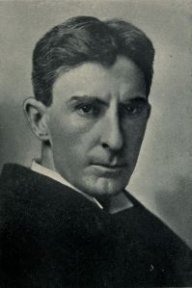
Thomas Dixon Jr. (1864-1846)Be that as it may Dixon was extremely popular in the years before the Bolshevik Revolution going into eclipse after his 1919 movie Bolshevism On Trial. So he was both a Southerner, although not a Virginian, and an anti-Communist giving him special appeal to Ed.
Born in 1864 he was old enough to have been aware during the last years of Reconstruction, hence an eyewitness. The grand tragedy of the Civil War for him was that Aryans exterminated Aryans over a worthless cause like Negro slavery. During Reconstruction the Puritan bigots of the North oppressed the Southern Aryans mercilessly so that Dixon made it his goal to reconcile Northern and Southern Aryans, thus the title of his and Griffiths 1915 movie titled The Birth Of A Nation, in other words, The Birth Of The Aryans as a Nation.
While slavery was the proximate cause of the war the issue takes a subordinate place in the minds of romanticists of the South such as Ed. Dixie is the home of courtly manners and magnolia blossoms, decency and self-respect.
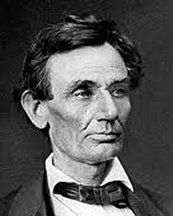
Abraham Lincoln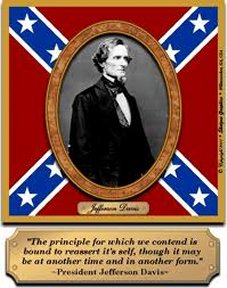
Jefferson DavisThat notion of a Utopia is still shared by many of us today.
The men who settled Virginia were the displaced younger sons of English aristocrats who gave their flavor to the Cavalier State. They were the epitome of desired manhood, the quality versus the equality -- hence John Carter of Virginia. Carter is not only a man but the apex of what a man should be.
Dixon wrote several Civil War and Reconstruction novels, all rather good literature. His most famous trilogy of the conflict was composed of The Leopardís Spots (1902), The Clansman (1905), and The Traitor (1907). As The Traitor is found in Burroughsí surviving library it is not unreasonable to believe he read all three and that before he began writing. Dixon wrote two further volumes, The Southerner: A Romance Of The Real Lincoln and The Victim: A Romance Of The Real Jefferson Davis of 1913 and 14 respectively. Iím sure Ed read them both but they were too late to be formative for his writing. I recommend them both highly for a near contemporary history of the events from the perspective of both sides. While it doesnít seem to be Dixonís purpose his presentation leaves no doubt in my mind that the assassination of Lincoln was plotted by a cabal of Northern bigots who really wanted to exterminate Southern Aryans replacing them with what they believed to be a pure Negro Republic.
As the Negroes were not welcome in the North these Northern loonies may have believed with Lincoln that Negroes and Aryans could not live together. They probably believed that by ceding the South to the Negroes they had solved the problem. Iím sure it goes much deeper than current research cares to deal with.
Fortunately that didnít happen. Reconstruction was overturned and the Jim Crow period took form resulting in the current Negro revolution with the threat of a San Domingo Moment.
In addition Dixon wrote an anti-socialist trilogy composed of One Woman (1903), Comrades (1909) and The Root Of Evil (1911). Other than reflecting the attitude of Edís thoughts they donít seem reflected in his own work before 1919, although they may appear in his 1926 novel The Moon Maid.
After the rejection of Edís own 1919 anti-Communist tract Under The Red Flag another work of Dixonís, The Fall Of A Nation (1916, both book and movie) seem to have been read and seen by Ed. The work would greatly influence Ed's 1926 novel, The Moon Maid.
So, Thomas Dixon has to be considered a major influence of EdĎs.
L. Frank Baum- The Wizard Of Oz
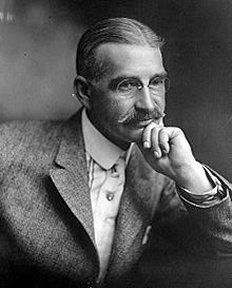
L. Frank Baum (1856-1919)A second major influence, not inferior to Dixon, was the great creator of the Wizard Of Oz series, Lyman Frank Baum. Although chronologically belonging to an earlier age cohort of writers he only began writing at the turn of the century, turning out his fabulously successful The Wonderful Wizard Of Oz in 1900. It is said that Oz was based on the White City of the Columbian Exposition of 1893 and most likely was. In those days before movies successful books were turned into equally successful plays as was the case with The Wizard; thus at forty-four Baum was launched on a successful literary career. As with so many writers he squandered his millions ending up virtually broke. He didnít live long enough for the movies to come to the rescue.
The original Wonderful Wizard Of Oz was written as a political satire which content went missing in 1939's movie, indeed, it was no longer relevant. Baum should have lived so long.
The Wonderful Wizard Of Oz (1900) was followed by The Marvelous Land Of Oz (1904), Ozma Of Oz (1907), Dorothy And The Wizard Of Oz (1908), The Road To Oz (1909) and the Emerald City Of Oz (1910). These were published before Ed began to write so they highly influenced his Martian Chronicles while subsequently issued titles influenced his later work.
Baum grew tired of the series trying to kill it off in 1910ís Emerald City Of Oz but the clamor urging him to write more resulted in the series being resumed in 1913. These titles in order where The Patchwork Girl Of Oz (1913), Tik Tok Of Oz (1914), The Scarecrow Of Oz (1915), Rinkitink In Oz (1916), The Lost Princess Of Oz (1917), The Tin Woodman Of Oz (1918), The Magic Of Oz (1919) and Glinda Of Oz (1920). There are an additional dozen or so Oz titles but they were commissioned (pastiches) after Baumís death to Ruth Plumly Thompson and another writer after her. Nice enough but donít have the spark.
One might say the Wizard far exceeds John Carter in the American consciousness while matching or even, possibly, exceeding that of Tarzan. Without the Tarzan movies the reputation of the Wizard would be as great while that of Tarzan would be significantly diminished.
Baum also wrote a comic strip of stories in 1905 and The Woggle Bug Book in 1905 that Ed may have seen, but I havenít.
One imagines Ed greatly anticipating each Oz book as it was released, stunned by both the stories and the W.W. Denslow and John R. Neill artwork. Always remember that Ed was a failed artist or cartoonist, so the illustration always remained important to him.
Baum like Ed, after having created, an original framework, unmercifully plundered past literature to give substance to his stories. As Ed would follow in his own Symmes' Hollow Earth stories, Baum wrote an entire Oz novel around a version of the Symmesís theory.
Ed so completely ingested the Baumian parallel universe that it is impossible to conceive of either Helium or Opar without reference to the Emerald City and hence back to Chicagoís White City. John Carter may be conceived of as a male Dorothy off to see the Wizard except that Helium was on Mars. Carterís accession to the Warlord of Mars may even be seen as a replacement of the Wizard. One suspects that for Ed Baum was the transcendent imagination.
Another important point, as David Adams points out, is that Baum was a theosophist versed in esoteric lore. Baum was among the writers of his day that Ed went out of the way to meet, to introduce himself. It may even be said that he had a relationship with Baum. Ed first introduced himself to Baum in 1913, driving up to Ozcot in Hollywood. The two men were reunited in 1916 during Edís stay in LA and again in 1919 for the few remaining months of Baumís life. He died in May of that year.
So Baum was a central figure in Edís career.
George Barr McCutcheon
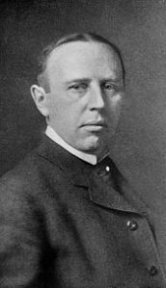
George Barr McCutcheon (1866-1926)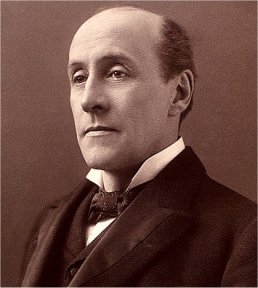
Anthony Hope (1863-1933)The third major figure of the decade succeeding 1900 was one George Barr McCutcheon and his Graustark series. Not so well known today he was a major figure in the early years of the century. Reminiscing in the forties in the midst of the disappointment of a second world war in his lifetime Ed remarked that the people then lacked a Graustark so that Ed added that imaginary land to the Oz in his literary memories.
Born in the same year as H.G. Wells, McCutcheonís first published title Graustark: The Story Of A Love Behind A Throne appeared in 1901 as the century began. Graustark was some Ruritanian paradise located in some imaginary middle European land of wine and waltzes. While a fine imaginary setting I find the novels unappealing. As usual one has the enterprising American lad among torpid European lumpkins.
Of the six Graustark novels three were published before 1912 -- Graustark (1901), Beverly Of Graustark (1904) and Truxton King: A Story Of Graustark (1909), and three after -- The Prince of Graustark (1914), East Of The Setting Sun (1924) and The Inn Of The Hawk And The Raven (1927). Thus only the first three were part of the formation of Edís memories when he began writing.
These three were however buttressed by two novels of Anthony Hope the man who invented Ruritanian romances and on whom McCutcheon undoubtedly based Graustark. Hope began his three dozen novel career with The Prisoner Of Zenda in 1894 followed by the sequel Rupert Of Hentzau in 1898. It would be truly astonishing if youíve heard of any of the rest of his oeuvre. I certainly never had.
The content of these novelists was directly incorporated into Edís two Ruritanian novels The Mad King and HRH The Rider.
The Mad King was a re-courting of Emma that apparently failed.
Booth Tarkington
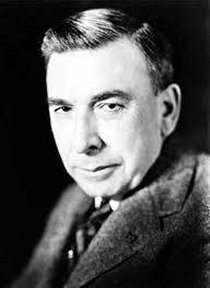
Booth Tarkington (1869-1946)A man who Ed thought was the greatest American writer when interviewed in the teens was the enchanting Booth Tarkington, one of the favorites of my childhood. I was enthralled by Tarkingtonís Tom Sawyer figure Penrod (1914) Scholfield and Penrod and Sam of 1916. The other titles I read back when were Seventeen (1916), The Magnificent Ambersons (1918), and Alice Adams of 1922.
Tarkington was a prolific writer turning out four dozen or so novels during his lifetime, some in collaboration with Harry Leon Wilson of Merton Of The Movies and Ruggles Of Red Gap fame along with several other significant titles of the day. Burroughs had Ruggles and couple others in his library.
Born between Wells and Ed, Tarkingtonís first novel, The Gentleman From Indiana appeared in 1899 followed by his Monsieur Beaucaire in 1900. A whole series of novels followed up to 1912 including The Two Vanrevels, so Ed probably had imbibed a lot of Tarkington before and much after 1912. Tarkington was a major influence on Edís novels such as The Oakdale Affair and The Efficiency Expert of the teens, while The Ambersons and Alice Adams influences show up in Edís 1924 novel Marcia Of The Doorstep.
Jack London
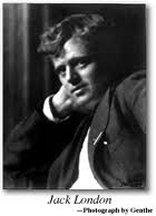
Jack London (1876-1916)Certainly not to be neglected as an influence is the still well known and often read Jack London. The making of London as a writer was the great Klondike Gold Rush beginning in 1896. In 1897 London packed his gear and went North. His experiences in the land of ice and snow provided the material that made his name. A stream of short stories and adventure novels erupted through his pen beginning in 1898 while the novels began in 1902. The Call Of The Wild of 1903 spoke to the wanderlust in Edís soul. London did everything that Ed wanted to do, he ranged freely over the entire world in his yacht The Snark, interestingly named after the great poem of Lewis Carroll Ö beware lest your Snark be a booÖ. He was an eyewitness reporter of the San Francisco earthquake of 1906, like Ed he was a boxing aficionado, he was ringside as a reporter when Jack Johnson put down the great Jim Jeffries to become the first Negro heavyweight champion.
Edís fascination with hoboing had never abated since he mingled with them on Madison, Chicagoís Main Stem, on which his fatherís factory was located. Londonís 1907 memoir of his cross country trip with Kelleyís Army, a part of Coxeyís Army in 1894 must have excited Ed enormously. But, Ed was tied to Emma and unable to roam.
In many ways Londonís and Edís views were in synch as part of the same age cohort. A Negroís winning of the boxing championship was really too much for either man to bear. London himself was an amateur boxer. The failure of a White man to appear to wrest the championship from the Negro Johnson drove him to distraction as it did Ed. Although living on either side of the country both expressed their anguish at the same time.
London wrote a preliminary study titled The Abysmal Brute following it with a full scale concerning the championship, The Valley Of The Moon in 1913. Ed set down and wrote The Mucker about his own hobo boxer, Billy Byrne also in 1913. One can only wonder how many other stories were written about an imaginary White boxer recapturing the crown.
The second novel of the Mucker Trilogy all but named London as its inspiration. The Return of the Mucker is a very good novel that celebrated the golden age of hoboing.
The novel tied in a number of Edís literary hobo sources. In addition to London the poet H.H. Knibbs provided a sort of framing device as Ed wove verses of his great poem Out There Somewhere through the story, essentially basing the novel on the poem. He also included snatches of verse from the Kiplingesque Robert W. Service of The Cremation Of Sam McGee fame.
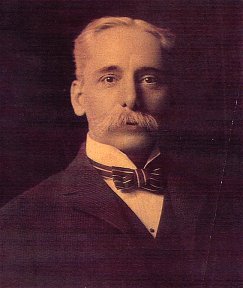
H.H. Knibbs (1874-1945)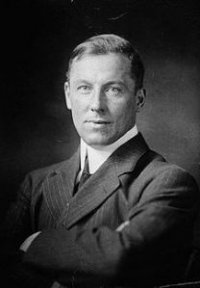
Robert Service (1874-1958)The Return then might be said to be a celebration of the road based on Londonís The Road and poems by Knibbs and Service. Byrne was also probably an attempt to create another series based on The Road to supplement Tarzan but it didnít take.
Zane Grey
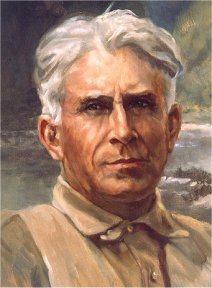
Zane Grey (1972-1939)Zane Grey might be one of the weaker influences before 1910, but Ed was destined to be thought a rival by his publishers. Grey had the magic touch in being able to pitch his is stories toward women thus garnering the big money of the slick magazines. Grey thus earned enough to buy himself a yacht making him the envy of Ed.
Grey began in 1903 with his story of Betty Zane. This was followed three years later by The Spirit Of The Border, then in 1908ís Last Of The Plainsmen. Nineteen nine brought The Last Trail and The Shortstop. The earlier titles were on small imprints while The Shortstop was publishing by McClurgís, the future publisher of Burroughs. From McClurgís Grey went to Harper And Bros. who remained his publisher from then on. One wonders if McClurgís sold his contract to Harperís or whether they signed him to a one book deal. They certainly tied Ed up contractually so he couldnít get away.
Greyís first book for Harperís in 1910 is the only story to indicate Edís readership, The Heritage Of The Desert concerning the Mormons. That influence showed up in 1913ísThe Cave Girl.
I could never get into Grey as a kid although I was given a copy of The Shortstop that I didnít read then and never have. Still have it though. Grey broke through in 1912 with Riders Of The Purple Sage. The Rainbow Trail and The Mysterious Rider are found in Edís library.
Iíve only read Edís two Western novels once so I would have to read them again to see how influenced they were by Grey.
Greyís stuff is alright I guess but the guyís a real dud writer as far as Iím concerned.
In addition to these major influences Ed also stuffed his memory with reams of poems and magazine articles. The newspapers which were much different then also provided much grist for his mill.
In the background, of course, was Edís interest in mythology. He did read Howard Pyleís four volume version of the Vulgate-Lancelot that appeared after the turn of the century. The two and a half years he spent at Harvard Latin School undoubtedly gave him a good background, while in those formative years conditioning his mind to deal with difficult thought processes. After all, the mind has to be trained to manage the mass of memories that make the person.
The question during this period is whether or not he read ancient Greek mythology or learned any Greek. I think not. He may have some familiarity with Homer especially The Odyssey on which many of his stories may be based. He was probably familiar with The Labors Of Hercules but I donít see any evidence of understanding of The Iliad.
The Iliad is important for psychology as Homer introduces the notion of the infinitely powerful mind of Zeus. Zeus could remember everything while having such a powerful mind that he could order the whole of it in sequence while finding his way through any number of conundrums. The only thing he couldnít do was set aside what was fated.
What goes into oneís memory or mind is of cardinal importance. Trash goes in, trash comes out. Ed filled his memory banks with useful information and wonderful speculative literature. The question, then, is what does one do with those memories now transformed into knowledge. Remembering is the sine qua non but organization is equally important. The mind must be trained. Remembered and organized, then what? Then comes intelligence and application. A flexible intelligence is probably known as imagination. One can combine, rearrange, and recombine oneís memories into new uses. Make meaningful what was formerly incoherent.
Ed, well-satisfied with himself, remarked that only one in a hundred thousand had a good imagination in which number he obviously included himself among the elite. I donít know where he got his stat but Iím sure a mind such as his was rare enough. There really arenít many who can use their mind as he did. One only has to read the Martian writers who preceded him to see the astonishing distance between their work and his. Wellsí War Of The Worlds for instance is a fairly pedestrian work. A missile shot from a cannon on Mars arrives on Earth and some spindly creatures get out who then mount some tripods that begin walking through London spewing some black gas. Fresh at the time, but not wildly imaginative. Ed would challenge Wells when he wrote the first third of The Moon Maid. That book was so imaginative, superior to Wellsí First Men In The Moon, as to be the work of a master taunting an obstreperous pupil.
So, when Ed Began 1912 his memory banks were full of experience and stuffed with literature and scientific knowledge that he was able to use so imaginatively that most people were completely unaware of the amount of learning incorporated into his stories.
Part VI chronicles Edís life from the beginning of his success to 1920.
|
|
|
|
|
|
|
|
|
|
WEB REFS
Many of the above titles may be found in ERB's Personal Library
www.ERBzine.com/dan
ERB's Novels are Featured in the Illustrated Bibliography
www.ERBzine.com/chaser
The ERB/Jack London Connection
The ERB/Zane Grey Connection
The ERB/HH Knibbs Connection
Columbian Exposition of 1893Previous discussion of many of the above authors may be found in the
RE Prindles series of ERBzine Articles
www.erbzine.com/mag13/1356.html
|
dugwarbaby@yahoo.com Meet R. E. Prindle and Follow the Navigation Chart for the Entire Series of Articles |
|
Differing viewpoints are welcome. |
|
are not necessarily those held by Edgar Rice Burroughs, Inc. |
![]()

![]()
![]()
BILL
HILLMAN: Editor and Webmaster
BILL
AND SUE-ON HILLMAN ECLECTIC STUDIO
ERB
Text, ERB Images and Tarzan® are ©Edgar Rice Burroughs, Inc.-
All Rights Reserved.
All
Original Work ©1996-2012/2013 by Bill Hillman and/or Contributing
Authors/Owners
No
part of this web site may be reproduced without permission from the respective
owners.